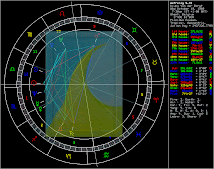
[..] Rousseau
is now best known for his jungle scenes, the first of which is
Surprised! (Tropical Storm with a
Tiger) (National
Gallery, London, 1891) and the last
The Dream (MOMA, New
York, 1910).[..]
http://www.library.vstu.edu.ru/gallery/Rousseau/Rousseau.htm
The first thing I noticed about
"Sleeping Gypsy" was that
it didn't have quite the feel of a 'signature expression', meaning
it has some measure of , what should I call it, jadedness (-
"worn out or
wearied, as by overwork or overuse".). Then noting that
"Surprised!"
was the first jungle painting, I was immediately reassured of
another of my heuristics; the earliest, initiating, work does have
more of the undiluted
horoscopic expressionism, and
less likely to be the result of some kind of self-imposed
censorship.
http://pedantus.free.fr/Rousseau_H_1_01.gif
The closest natal aspect is Mars trine Neptune, and Mars has the
most close aspects (orbs of one degree or less):
http://www.astro.com/astro-databank/Rousseau,_Henri
Having no idea the exact date of the painting's appearance, I
used July 1, 1891 as the approximate date, thus just pointing at the
middle of the given year. Here is a natal chart showing the Sun's progressed
position:
http://pedantus.free.fr/Rousseau_H_2a.gif
A natal and transit projection shows the prominence of
t-Uranus during the year of the the first jungle painting,
"Surprised!"
:
http://pedantus.free.fr/Rousseau_H_2b.gif
Here then is the layered projection of the combined natal chart
and painting:
http://pedantus.free.fr/Rousseau_H_1a.gif
Here I have isolated a portion of his composition (encircled with
a white dotted line) to show how Mars trine Neptune presents using a
metaphor of active red leaves--a 50/50 blend of the characterists of
each planet, at least as I have come to appreciate and or expect
their respective appearances in drawings. When the painter is free
of the need to project multiple objects of recognition, the planets
'energies' are much less diluted:
http://pedantus.free.fr/Rousseau_H_3a.gif
Note the singular presence of a circular object, the 'eye' of
the tiger; it of course even has a dot in it. It is the
token of
the natal Sun's
house position, relative to the area
covered by one's visual perception field, or
gaze. Because
we apparently project our human habit of interpreting spacial
relationships like this, as if we were unconsciously guided by the
philosophical deconstruction of what we see, the visual positions of
house positions is an emergent linguistic phenomenon. If we look at
the last formal philosopher's work (/creative self-expression),
Hegel's systematic idealism, his dialectical tensions are easily
mapped on to the Zodiac which does serves as something of a
Rosetta Stone showing an overlap of visual and natural language (I have substituted
Authority and
Responsibility
for his thematic
Master and Slave dialectic). This because,
this is apparently how we humans
think or at least intuit
the holistic system of mind/psyche:
http://pedantus.free.fr/HegelsDialectics_01.gif
So, then, the "houses" are in us, so to speak, these generalizing abstracts exist for us to project when we do the intuitive process of perceiving the more image-less relations between idealized concepts--the
incomprehensible mind magic of perceptual gestalt, the recognition
of wholes as being something other than the mere sum of their parts--parts that we are
free to seek out only as a matter of secondary experiences, our habit of
post-impression analysis out of pure curiosity I guess.
What I am endeavoring to show here, in general, is that we can observe persons
expressing that which astrology calls a natal chart in their own
personal innate
dialect--the language of the unique self as it
exists, immersed as it is, in its specific experiential
social/cultural milieu. Rousseau's
tiger is pointed, teeth
and claws, at the visual equivalent of his natal Mars astrological
house position--a
graphic version of the
Gauquelin "Mars Effect"....the
difference being that in graphic arts we do not need a heavy
emphasis on the Gauquelin sectors, we can see Mars as projected
into any house position as need be to parallel the internal language
of the psyche and its ineffable Self
'image'.
Basically, the fluffy translucent looking tops of reeds we see at the left hand side of Rousseau's
"Surprised!" --at
the visual place of the astrological
Ascendant,
is
"Neptune", (likewise all the leafy flowing material) The tiger's
eye
is the natal Sun, and the all the movement of the
storm's assertive invisible air directs our attention the general location of natal Mars.
"Surprise" is then, by comparison
to Rousseau's oeuvre, relatively much more the signature
expression--an instance of horoscopic expressionism has taken place with enough
explicitness that one could closely approximate the painter's
specific
birth time, if it were not already a given. The
trick, now, is to learn how we can recognize a signature expression, so
that the objectivity presumed to be totally missing from astrology can be more empirically demonstrated, at least in part, as abstract language and visual metaphors signifying the individual psyche more in a fingerprint manner of
demarcation, simply as an expression individuated identity, its relationship to time.
%20(3).jpg)

%20(2).jpg)









